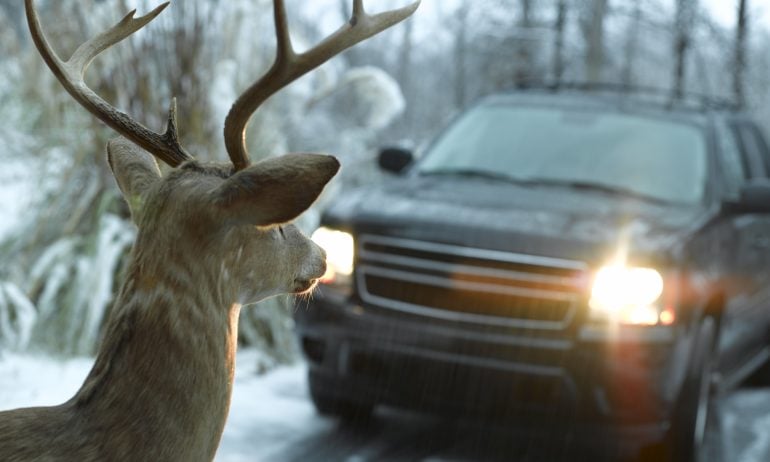What Drivers Need to Know About Deer Season and Car Insurance

Many or all of the products featured here are from our partners who compensate us. This influences which products we write about and where and how the product appears on a page. However, this does not influence our evaluations. Our opinions are our own. Here is a list of our partners and here's how we make money.
Deer-car accidents can cause injuries, damage and even death, and are more likely to happen in late fall, when hunters are out and animals are on the move. In addition to endangering your health and property, an accident involving a deer can cost you thousands of dollars out of pocket if you don’t have the right kind of car insurance.
» MORE: What does car insurance cover?

About 1.9 million deer, elk and moose are struck each year, causing more than $1 billion in insured losses and affecting about one in 127 drivers, according to the National Association of Insurance Commissioners and State Farm. Collisions peak in November, the height of hunting and mating season.
The insurance company also noted that animal collisions caused 164 driver or passenger deaths in 2021, the latest year for which data was available.
If you do strike an animal, damage to your car will be covered only if you have comprehensive insurance. If you lease your vehicle or have a car loan, your lender likely requires you to have this type of coverage. Comprehensive coverage is strongly recommended for all drivers, unless your car has very little value.
Collision coverage (which generally is sold as a package with comprehensive) won’t pay for damage caused by hitting an animal. However, collision could apply if you swerve to miss an animal and hit something else instead, such as a fence.
That means buying only the minimum car insurance in your state likely won’t protect you if you hit a deer or other animal. For instance, in West Virginia, the minimum is liability and uninsured motorist coverage. That puts many West Virginia drivers at risk, especially because they face a 1 in 38 chance of striking a deer, elk or moose, the highest rate in any state.
West Virginia topped State Farm’s list of states for collisions with deer, elk and moose, based on claims data, animal population levels and other factors.
Although adding comprehensive coverage may increase your car insurance premium, you can lower the cost by choosing a higher deductible, which is the amount you will be responsible for on any claim.
The trouble spots
Even though West Virginia is No. 1 for deer, elk or moose crashes, the risk for drivers there has decreased from last year’s 1 in 39 chance, according to State Farm. Here are the five states where you are most likely to have a collision with a deer, elk or moose, according to State Farm:
West Virginia (1 in 38 chance)
Montana (1 in 53 chance)
Iowa (1 in 63 chance)
Pennsylvania (1 in 59 chance)
South Dakota (1 in 69 chance)
It’s not unusual for deer-accident rates to change every year. Factors that affect the odds include deer population levels, winter weather, and new or improved roads with higher speed limits.
While November is the peak month for collisions, you’re also more than twice as likely to hit a deer in October, November or December than in other months of the year, according to State Farm. These months are breeding season, which means males are traveling widely in search of females. Some herds also migrate during this time.
How to improve your odds
You’re more likely to hit a deer in the hours from dusk until dawn, when the animals are most active. Improve your safety with these tips:
Be extra careful when driving in areas known to have many deer.
Deer often move in groups, so if you see one animal, slow down and look for others.
Use high beams at night unless there is oncoming traffic.
Do not swerve if you see a deer. Doing so could send you off the road or into oncoming traffic.

If the worst happens
Sometimes an accident is inevitable no matter how careful you are. Deer can dash out from cover with no warning, giving you no chance to stop.
If you hit a deer:
Move your vehicle off the road and turn on your hazard lights. Call the police. If possible, take pictures of the scene and any injuries to passengers or damage to the vehicle, for insurance purposes.
If the animal runs away after the accident, get a picture of hair or blood on the car to show that a deer was involved. Use this evidence to have the accident processed under comprehensive coverage.
Get contact information from any witnesses, especially if the animal runs off. If witnesses are able to wait, ask them to report what they saw to the police.
Even if you think the damage is minimal, check to be sure your vehicle is safe to drive. Look for tire damage, broken lights, fluid leaks or loose parts. You may need to call a tow truck.
Do not approach the deer, even if you think it’s dead. A wounded animal could injure you.
All of us are at some risk for hitting deer because they can be found just about anywhere, even in Manhattan. The right insurance policy plus defensive driving skills can greatly reduce your chances of injury and uncompensated expense. Do you need comprehensive coverage? NerdWallet's car insurance comparison tool makes it easy to compare rates.
Donna Freedman is a former contributing writer for NerdWallet.
On a similar note...

